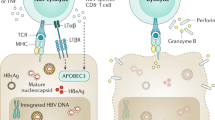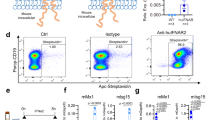Abstract
Hepatitis B virus (HBV) reactivation and recurrence are common in patients undergoing immunosuppression therapy. Tumor necrosis factor (TNF) blockage therapy is effective for the treatment of many autoimmune inflammatory diseases. However, the role of TNF-α blockage therapy in the innate and adaptive immune responses against HBV is still not clear. A detailed analysis of HBV infection under TNF-α blockage therapy is essential for the prophylaxis and therapy for HBV reactivation and recurrence. In this study, HBV clearance and T-cell responses were analyzed in a HBV-transfected mouse model under anti-TNF blockage therapy. Our results demonstrated that under TNF-α blockage therapy, HBV viral clearance was impaired with persistent elevated HBV viral load in a dose- and temporal-dependent manner. The impairment of HBV clearance under anti-TNF-α blockage therapy occurred at early time points after HBV infection. In addition, TNF-α blockade maintained a higher serum HBV viral load and increased the number of intrahepatic programmed cell death (PD)-1highCD127low exhausted T cells. Furthermore, TNF-α blockade abolished Toll-like receptor 9 (TLR9) ligand-induced facilitation of HBV viral clearance. Taken together, TNF-α blockade impairs HBV clearance and enhances viral load, and these effects depend on early administration after HBV infection. Our results here demonstrate that early TNF-α blockade reduces viral clearance and persistently maintains elevated HBV viral load in a mouse model, suggesting that HBV may reactivate during therapy with TNF-α-blocking agents.
This is a preview of subscription content, access via your institution
Access options
Subscribe to this journal
Receive 12 digital issues and online access to articles
$119.00 per year
only $9.92 per issue
Buy this article
- Purchase on Springer Link
- Instant access to full article PDF
Prices may be subject to local taxes which are calculated during checkout




Similar content being viewed by others
References
Merican I, Guan R, Amarapuka D, Alexander MJ, Chutaputti A, Chien RN et al. Chronic hepatitis B virus infection in Asian countries. J Gastroenterol Hepatol 2000; 15: 1356–1361.
Bertoletti A, Ferrari C . Innate and adaptive immune responses in chronic hepatitis B virus infections: towards restoration of immune control of viral infection. Gut 2012; 61: 1754–1764.
Durantel D, Zoulim F . Innate response to hepatitis B virus infection: observations challenging the concept of a stealth virus. Hepatology 2009; 50: 1692–1695.
Bertoletti A, Ferrari C . Innate and adaptive immune responses in chronic hepatitis B virus infections: towards restoration of immune control of viral infection. Postgrad Med J 2013; 89: 294–304.
Dunn C, Peppa D, Khanna P, Nebbia G, Jones M, Brendish N et al. Temporal analysis of early immune responses in patients with acute hepatitis B virus infection. Gastroenterology 2009; 137: 1289–1300.
Guo H, Jiang D, Ma D, Chang J, Dougherty AM, Cuconati A et al. Activation of pattern recognition receptor-mediated innate immunity inhibits the replication of hepatitis B virus in human hepatocyte-derived cells. J Virol 2009; 83: 847–858.
Baron JL, Gardiner L, Nishimura S, Shinkai K, Locksley R, Ganem D . Activation of a nonclassical NKT cell subset in a transgenic mouse model of hepatitis B virus infection. Immunity 2002; 16: 583–594.
Bonorino P, Ramzan M, Camous X, Dufeu-Duchesne T, Thelu MA, Sturm N et al. Fine characterization of intrahepatic NK cells expressing natural killer receptors in chronic hepatitis B and C. J Hepatol 2009; 51: 458–467.
Gao B, Radaeva S, Park O . Liver natural killer and natural killer T cells: immunobiology and emerging roles in liver diseases. J Leukoc Biol 2009; 86: 513–528.
Nattermann J, Feldmann G, Ahlenstiel G, Langhans B, Sauerbruch T, Spengler U . Surface expression and cytolytic function of natural killer cell receptors is altered in chronic hepatitis C. Gut 2006; 55: 869–877.
Chisari FV . Cytotoxic T cells and viral hepatitis. J Clin Invest 1997; 99: 1472–1477.
Guidotti LG, Chisari FV . Cytokine-induced viral purging—role in viral pathogenesis. Curr Opin Microbiol 1999; 2: 388–391.
Guidotti LG, Ishikawa T, Hobbs MV, Matzke B, Schreiber R, Chisari FV . Intracellular inactivation of the hepatitis B virus by cytotoxic T lymphocytes. Immunity 1996; 4: 25–36.
Guidotti LG, Rochford R, Chung J, Shapiro M, Purcell R, Chisari FV . Viral clearance without destruction of infected cells during acute HBV infection. Science 1999; 284: 825–829.
Kasahara S, Ando K, Saito K, Sekikawa K, Ito H, Ishikawa T et al. Lack of tumor necrosis factor alpha induces impaired proliferation of hepatitis B virus-specific cytotoxic T lymphocytes. J Virol 2003; 77: 2469–2476.
Tzeng HT, Tsai HF, Chyuan IT, Liao HJ, Chen CJ, Chen PJ et al. Tumor necrosis factor-alpha induced by hepatitis B virus core mediating the immune response for hepatitis B viral clearance in mice model. PLoS One 2014; 9: e103008.
Day CL, Kaufmann DE, Kiepiela P, Brown JA, Moodley ES, Reddy S et al. PD-1 expression on HIV-specific T cells is associated with T-cell exhaustion and disease progression. Nature 2006; 443: 350–354.
Lang KS, Recher M, Navarini AA, Harris NL, Lohning M, Junt T et al. Inverse correlation between IL-7 receptor expression and CD8 T cell exhaustion during persistent antigen stimulation. Eur J Immunol 2005; 35: 738–745.
Petrovas C, Casazza JP, Brenchley JM, Price DA, Gostick E, Adams WC et al. PD-1 is a regulator of virus-specific CD8+ T cell survival in HIV infection. J Exp Med 2006; 203: 2281–2292.
Ye P, Weng ZH, Zhang SL, Zhang JA, Zhao L, Dong JH et al. Programmed death-1 expression is associated with the disease status in hepatitis B virus infection. World J Gastroenterol 2008; 14: 4551–4557.
Mease PJ, Goffe BS, Metz J, VanderStoep A, Finck B, Burge DJ . Etanercept in the treatment of psoriatic arthritis and psoriasis: a randomised trial. Lancet 2000; 356: 385–390.
Su CG, Judge TA, Lichtenstein GR . The role of biological therapy in inflammatory bowel disease. Drugs Today (Barc) 2001; 37: 121–133.
Taylor PC . Anti-TNF therapy for rheumatoid arthritis and other inflammatory diseases. Mol Biotechnol 2001; 19: 153–168.
Perez-Alvarez R, Diaz-Lagares C, Garcia-Hernandez F, Lopez-Roses L, Brito-Zeron P, Perez-de-Lis M et al. Hepatitis B virus (HBV) reactivation in patients receiving tumor necrosis factor (TNF)-targeted therapy: analysis of 257 cases. Medicine (Baltimore) 2011; 90: 359–371.
Tamori A, Koike T, Goto H, Wakitani S, Tada M, Morikawa H et al. Prospective study of reactivation of hepatitis B virus in patients with rheumatoid arthritis who received immunosuppressive therapy: evaluation of both HBsAg-positive and HBsAg-negative cohorts. J Gastroenterol 2011; 46: 556–564.
Huang LR, Wu HL, Chen PJ, Chen DS . An immunocompetent mouse model for the tolerance of human chronic hepatitis B virus infection. Proc Natl Acad Sci USA 2006; 103: 17862–17867.
Lin YJ, Huang LR, Yang HC, Tzeng HT, Hsu PN, Wu HL et al. Hepatitis B virus core antigen determines viral persistence in a C57BL/6 mouse model. Proc Natl Acad Sci USA 2010; 107: 9340–9345.
Yeh SH, Tsai CY, Kao JH, Liu CJ, Kuo TJ, Lin MW et al. Quantification and genotyping of hepatitis B virus in a single reaction by real-time PCR and melting curve analysis. J Hepatol 2004; 41: 659–666.
Boni C, Fisicaro P, Valdatta C, Amadei B, Di Vincenzo P, Giuberti T et al. Characterization of hepatitis B virus (HBV)-specific T-cell dysfunction in chronic HBV infection. J Virol 2007; 81: 4215–4225.
Boettler T, Panther E, Bengsch B, Nazarova N, Spangenberg HC, Blum HE et al. Expression of the interleukin-7 receptor alpha chain (CD127) on virus-specific CD8+ T cells identifies functionally and phenotypically defined memory T cells during acute resolving hepatitis B virus infection. J Virol 2006; 80: 3532–3540.
Huang LR, Wohlleber D, Reisinger F, Jenne CN, Cheng RL, Abdullah Z et al. Intrahepatic myeloid-cell aggregates enable local proliferation of CD8+ T cells and successful immunotherapy against chronic viral liver infection. Nat Immunol 2013; 14: 574–583.
Guidotti LG, Chisari FV . Immunobiology and pathogenesis of viral hepatitis. Annu Rev Pathol 2006; 1: 23–61.
Romero R, Lavine JE . Cytokine inhibition of the hepatitis B virus core promoter. Hepatology 1996; 23: 17–23.
Biermer M, Puro R, Schneider RJ . Tumor necrosis factor alpha inhibition of hepatitis B virus replication involves disruption of capsid Integrity through activation of NF-kappaB. J Virol 2003; 77: 4033–4042.
Gilles PN, Fey G, Chisari FV . Tumor necrosis factor alpha negatively regulates hepatitis B virus gene expression in transgenic mice. J Virol 1992; 66: 3955–3960.
Neta R, Oppenheim JJ, Douches SD . Interdependence of the radioprotective effects of human recombinant interleukin 1 alpha, tumor necrosis factor alpha, granulocyte colony-stimulating factor, and murine recombinant granulocyte-macrophage colony-stimulating factor. J Immunol 1988; 140: 108–111.
Yang PL, Althage A, Chung J, Maier H, Wieland S, Isogawa M et al. Immune effectors required for hepatitis B virus clearance. Proc Natl Acad Sci USA 2010; 107: 798–802.
Calin A, Dijkmans BA, Emery P, Hakala M, Kalden J, Leirisalo-Repo M et al. Outcomes of a multicentre randomised clinical trial of etanercept to treat ankylosing spondylitis. Ann Rheum Dis 2004; 63: 1594–1600.
Ledingham J, Deighton C . Update on the British Society for Rheumatology guidelines for prescribing TNFalpha blockers in adults with rheumatoid arthritis (update of previous guidelines of April 2001). Rheumatology (Oxford) 2005; 44: 157–163.
Siddiqui MA, Scott LJ . Spotlight on infliximab in Crohn disease and rheumatoid arthritis. BioDrugs 2006; 20: 67–70.
Ye H, Zhang XW, Mu R, Fang LK, Gu JR, Lin J et al. Anti-TNF therapy in patients with HBV infection—analysis of 87 patients with inflammatory arthritis. Clin Rheumatol 2014; 33: 119–123.
de la Torre I, Valor L, Nieto JC, Montoro M, Carreno L . Minimum effective dosages of anti-TNF in rheumatoid arthritis: a cross-sectional study. Reumatol Clin 2013; 10: 101–104.
Moots RJ, Haraoui B, Matucci-Cerinic M, van Riel PL, Kekow J, Schaeverbeke T et al. Differences in biologic dose-escalation, non-biologic and steroid intensification among three anti-TNF agents: evidence from clinical practice. Clin Exp Rheumatol 2011; 29: 26–34.
Isogawa M, Furuichi Y, Chisari FV . Oscillating CD8+ T cell effector functions after antigen recognition in the liver. Immunity 2005; 23: 53–63.
Raziorrouh B, Schraut W, Gerlach T, Nowack D, Gruner NH, Ulsenheimer A et al. The immunoregulatory role of CD244 in chronic hepatitis B infection and its inhibitory potential on virus-specific CD8+ T-cell function. Hepatology 2010; 52: 1934–1947.
Schurich A, Khanna P, Lopes AR, Han KJ, Peppa D, Micco L et al. Role of the coinhibitory receptor cytotoxic T lymphocyte antigen-4 on apoptosis-prone CD8 T cells in persistent hepatitis B virus infection. Hepatology 2011; 53: 1494–1503.
Acknowledgements
We thank Dr Shie-Liang Hsieh for critically reviewing the manuscript and Ms W-L Wang and Y-L Chen for assistance. This work was supported by grants from the National Science Council, Taiwan (NSC98-3112-B-002-047, NSC101-2320-B-038-019-, NSC 101-2321-B-002-008- and 102-2320-B-038 -040-MY3).
Author information
Authors and Affiliations
Corresponding author
Additional information
Supplementary information accompanies the paper on Cellular & Molecular Immunology's website.
Supplementary information
Rights and permissions
About this article
Cite this article
Chyuan, IT., Tsai, HF., Tzeng, HT. et al. Tumor necrosis factor-alpha blockage therapy impairs hepatitis B viral clearance and enhances T-cell exhaustion in a mouse model. Cell Mol Immunol 12, 317–325 (2015). https://doi.org/10.1038/cmi.2015.01
Received:
Revised:
Accepted:
Published:
Issue Date:
DOI: https://doi.org/10.1038/cmi.2015.01
Keywords
This article is cited by
-
TNF in the liver: targeting a central player in inflammation
Seminars in Immunopathology (2022)
-
Oncofetal gene SALL4 reactivation by hepatitis B virus counteracts miR-200c in PD-L1-induced T cell exhaustion
Nature Communications (2018)
-
Tumor necrosis factor: The key to hepatitis B viral clearance
Cellular & Molecular Immunology (2018)
-
γδ T cells in liver diseases
Frontiers of Medicine (2018)
-
Development and Validation of a Nomogram for Predicting Survival in Patients with Advanced Pancreatic Ductal Adenocarcinoma
Scientific Reports (2017)



